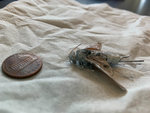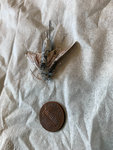

When Mark Olsen, a Grand Mound resident, encountered what looked like a bee and measured about an inch-and-a-half in length Monday morning, he didn’t know what to make of it.
“I was out by the wood pile and I saw it fly into the bark and I thought it was maybe a queen bee or something,” Olsen said.
Another possibility arose, albeit unlikely: did Olsen have an encounter with an Asian giant hornet?
There have only been five confirmed findings of Asian giant hornets, sometimes referred to as “murder hornets,” in Washington, according to the Washington State Department of Agriculture.
Facing a bug that appeared to have a quarter-inch stinger, Olsen grabbed the nearest weapon of defense he could find — in this case, a canister of white spray paint — and doused the insect, catching it dead in its tracks.
Olsen delivered the insect’s corpse to The Chronicle, where staff took a picture of it and sent it to the WSDA to determine whether Olsen, in fact, had an unlikely encounter with an Asian giant hornet.
WSDA spokesperson Chris McGann immediately confirmed with The Chronicle that the insect was not an Asian giant hornet. He added that it is incredibly unlikely that anyone within Lewis County would come across an Asian giant hornet, with all of the confirmed findings being confined to the northwest region of Washington near the Canadian border.
What is much more likely, said McGann in a text message, is that Olsen had an encounter with a wood wasp, which shares a characteristic with the Asian giant hornet of being larger than the typical bee or wasp, but that is about it.
“That’s probably why it went in the wood pile because it’s a wood wasp,” Olsen reasoned after hearing the critter was not an Asian giant hornet.
Furthermore, the wood wasp is entirely harmless, McGann added.
What appears to be a stinger on the wood wasp that Olsen coated in white paint isn’t actually a stinger at all. It is an ovipositor, which wood wasps use to lay eggs. Wood wasps do not possess the ability to sting a person at all.
Wood wasps do, however, possess the ability to give any person not particularly keen on insects a scare, Olsen would argue.
According to the WSDA website, Asian giant hornets are the world’s largest hornet, measuring anywhere from one-and-a-half to two inches in length, with a large orange head, prominent eyes and a black and orange-striped abdomen. Asian giant hornets are known for forming large colonies that typically nest in the ground.
While they do not generally behave aggressively toward humans, they can attack if they feel threatened. In some cases, stings from the Asian giant hornet can be fatal.
There is no way of knowing precisely how the Asian giant hornet was introduced to the Pacific Northwest. Possibilities include the hornet venturing over in an international shipping container, purchases that have been shipped to the U.S. or travelers visiting the U.S. or returning home from another country, but there is no way of confirming these theories.
The WSDA’s plan for managing the introduction of Asian giant hornets is to trap the insects, tag them, then track them back to their colony where the WSDA can eradicate the colony.
The WSDA has a team of entomologists collaborating with federal and international experts to manage the Asian giant hornet population.
As of Friday, Washington citizens alone have collectively put up 1,300 traps in hopes of capturing an Asian giant hornet, however, the WSDA would advise anyone living outside of Washington to not set up traps because it would only kill other insects with no benefit.
For more information on the Asian giant hornet, visit https://agr.wa.gov/departments/insects-pests-and-weeds/insects/hornets